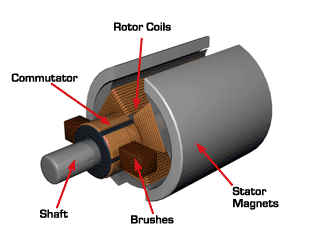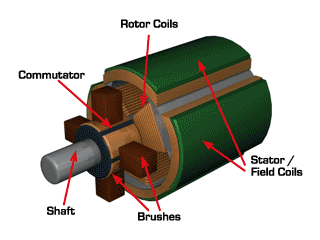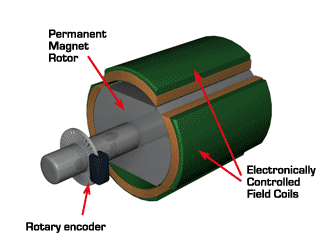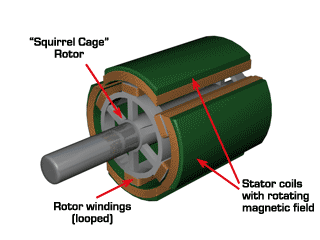At the heart of every EV is an electric motor. This is what makes the car actually move, instead of an Internal Combustion Engine as used in conventional vehicles. By comparison electric motors are very simple machines offering extremely high reliability, with virtually zero maintenance, and efficiency up to 98% (vs around 25% for an ICE). Electric motors come in a huge variety of designs, but the three most common topologies used in EVs are are DC, BLDC, and AC induction.
DC Motors
|
There are four main types of DC motor, namely permanent magnet,
series, shunt and seperately excited. The latter three all use
field coils in the stator (the part which doesn't move) to generate
a magnetic field for the rotor to spin in, and their name simply
refers to the way the field coils are wired with respect to the
rotor coils. All four types use a commutator to control which
rotor coils are energised at any given time in order to maintain
rotation, and it is enough just to apply a DC voltage across their
terminals to get the motor to spin, so they are relatively easy
to control.
Currently series DC are the most economical and commonly used type
of motor in electric vehicle conversions. Being a mature technology,
they do perform well, with efficiencies up to 90%
and only needing servicing every 100,000kms or so. However using
a commutator is restrictive and is a source of inefficiency. Also,
with series DC motors regenerative braking is very difficult to
do, so is not commonly seen. Regen can increase your range by 10-20%, so is quite
valuable.
Though still popular for EV conversions, all modern mass-produced electric vehicles tend not to use DC motors, instead favouring BLDC or AC induction motors.
Some popular brands of DC motors for EVs are Advanced
DC, NetGain and Kostov Motors. |

Permanent Magnet DC Motor

DC Motor with wound stator
|
Brushless DC Motors
| In a brushless DC motor (BLDC, also known as Permanent Magnet Synchronous Motor/PMSM or Permanent Magnet AC), the rotor has permanent magnets
and the stator has an electronically-controlled rotating field,
using sensors (rotor angle sensors or back-EMF) to detect rotor position.
As such they have no commutator, and tend to be more efficient
and more power-dense than commutated motors. They do require a more
complicated motor controller, although as the technology matures
and costs come down they are becoming increasingly popular, particularly
for smaller motors.
The main disadvantage for EV use is the cost of the large permanent
magnet(s) required for the rotor, and the added expense of the
more complicated motor controller. At present BLDC drive systems are still considerable more expensive than their brushed DC counterparts.
|

Brushless DC Motor ("in-runner" type)
|
AC Motors
| Although there are a variety of motors which will run on AC power (including BLDC above),
for EV use it usually refers to AC induction.
The operation of induction motors is a somewhat difficult concept
to grasp at first. Basically they use a rotating magnetic field
in the stator to induce a magnetic field in the rotor and hence
a current to flow in the rotor's coils. The rotor coils actually
just loop around on themself - they are not explicitly powered.
The induced field in the rotor tries to stay aligned with the
rotating field of the stator, so it turns to chase the stator's
field. Due to loads on the motor, the rotor's field is forced
to rotate slightly slower than the stator's field (if it kept
up exactly, there would be no difference in the fields and hence
no torque).
Three phase induction motors are very common for industrial use
because they are highly efficient and reliable. These same advantages
apply for electric vehicle use, except for the added complication
that a variable-speed inverter (sometimes called a Variable Frequency Drive or VFD) is required to control the AC motor
from a DC power supply (the battery). These are a relatively expensive
piece of hardware. Although they do include regenerative braking
and are generally more efficient, primarily due to the expensive controller AC systems currently cost at least
twice as much as series DC for equivalent power.
The most popular brands for AC induction motors suitable for EVs
are Siemens and Azure
Dynamics. It is also possible to use industrial AC equipment from manufacturers such as ABB and Danfoss. |

AC Induction Motor
|
The Future
Currently, the most economical (and indeed common) option for electric vehicles
is series DC technology. However, it is likely that all commutated motors
will be phased out over the next decade or two, since a commutator's functionality
can be replaced by clever electronics (which is getting cheaper every day),
and with improved reliability and efficiency. At present, AC induction and
permanent magnet brushless DC are the best technologies available, with efficiencies
up to 98%, very quiet operation, and almost never requiring any servicing. They
each have various advantages and disadvantages over one another so it will be
interesting to see which one becomes the new standard in the years to come.
|




